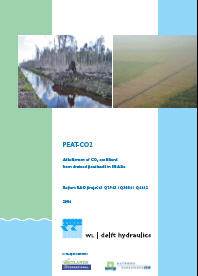
Peat CO2
-
Climate mitigation and adaptation
This report presents shocking figures on CO2 emissions from drained peatland areas. These areas were once swamp forests. Due to extensive drainage for logging, palm oil plantations and pulp wood, the peat oxidates into huge amounts of carbon dioxide (CO2).
Forested tropical peatlands in SE Asia store at least 42,000 Megatonnes of soil carbon (twice the total yearly annual emissions). This carbon is increasingly released to the atmosphere due to drainage and fires associated with plantation development and logging. Emissions from South-east Asian peatlands count now already for 8% of the global emissions.
One important crop in drained peatlands is palm oil, which is increasingly used as a biofuel in Europe. Especially the drainage for this crop is intense and leads to emissions between 70 and 100 tonne carbon dioxide a year for each hectare.
In the PEAT-CO2 project, present and future emissions from drained peatlands were quantified using the latest data on peat extent and depth, present and projected land use and water management practice, decomposition rates and fire emissions.
Peatland degradation & conversion
Out of 27 million hectares of South-eas Asian peatland, 12 million hectares (45%) are currently deforested and mostly drained. Peatlands are drained to enable forestry. After deforestation, drainage is in many areas intensified to establish large scale plantations (oil palm, acacia wood, etcetera). Especially the emissions from these plantations are very high, up to a hundred tonne CO2 per hectare a year, compared to only a few tonnes from recently logged areas. Natural peatlands do not release any carbon dioxide.
It was found that current likely CO2 emissions of drained peatlands caused by decomposition only, amounts to 632 Mt/y (between 355 and 874 Mt/y). This emission will increase in coming decades unless land management practices and peatland development plans are changed, and will continue well beyond the 21st century.
In addition, over 1997-2006 an estimated average of 1400 Mt/y in CO2 emissions was caused by peatland fires that are also associated with drainage and degradation.
The current total peatland CO2 emission of 2000 Mt/y equals almost 8% of global emissions from fossil fuel burning. These emissions have been rapidly increasing since 1985 and will further increase unless action is taken. Over 90% of this emission originates from Indonesia, which puts the country in 3rd place (after the USA and China) in the global CO2 emission ranking.
Conclusion: peatlands significant source of CO2 emissions
It is concluded that deforested and drained peatlands in SE Asia are a globally significant source of CO2 emissions and a major obstacle to meeting the aim of stabilizing greenhouse gas emissions, as expressed by the international community. It is therefore recommended that international action is taken to help SE Asian countries, especially Indonesia, to better conserve their peat resources through forest conservation and through water management improvements aiming to restore high water tables.
Author(s): Aljosja Hooijer (Delft Hydraulics), Henk Wösten (Alterra), Marcel Silvius (Wetlands International), Susan Page
A study of Delft Hydraulics in cooperation with Wetlands International and Alterra.

